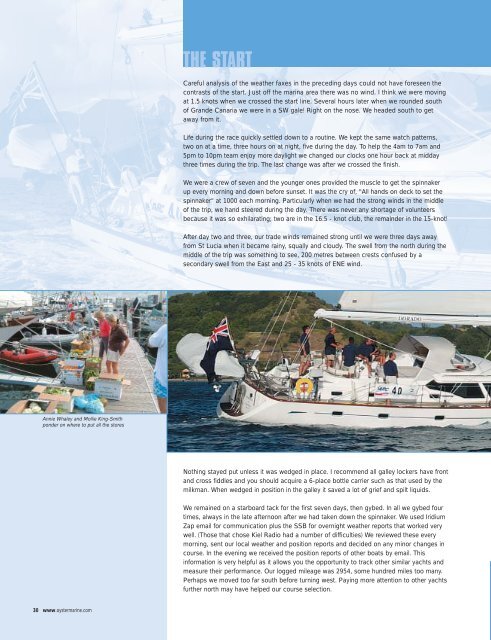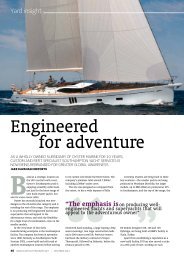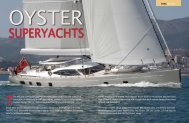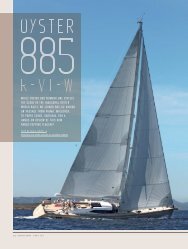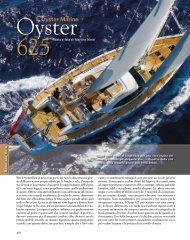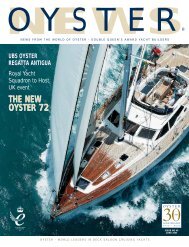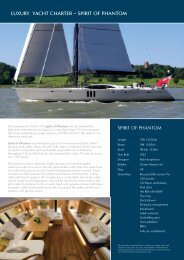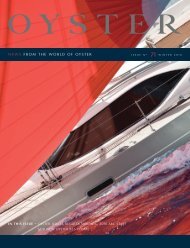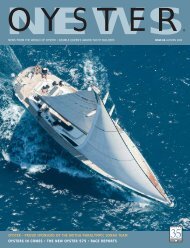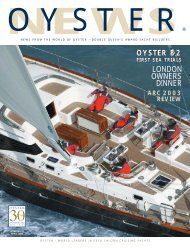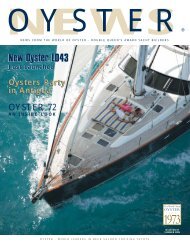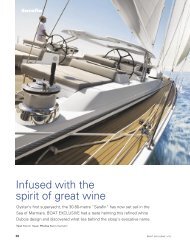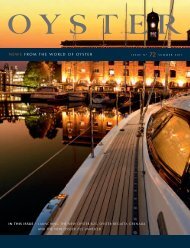THE STARTCareful analysis of the weather faxes in the preceding days could not have foreseen thecontrasts of the start. Just off the marina area there was no wind. I think we were movingat 1.5 knots when we crossed the start line. Several hours later when we rounded southof Grande Canaria we were in a SW gale! Right on the nose. We headed south to getaway from it.Life during the race quickly settled down to a routine. We kept the same watch patterns,two on at a time, three hours on at night, five during the day. To help the 4am to 7am and5pm to 10pm team enjoy more daylight we changed our clocks one hour back at middaythree times during the trip. The last change was after we crossed the finish.We were a crew of seven and the younger ones provided the muscle to get the spinnakerup every morning and down before sunset. It was the cry of, "All hands on deck to set thespinnaker" at 1000 each morning. Particularly when we had the strong winds in the middleof the trip, we hand steered during the day. There was never any shortage of volunteersbecause it was so exhilarating; two are in the 16.5 - knot club, the remainder in the 15-knot!After day two and three, our trade winds remained strong until we were three days awayfrom St Lucia when it became rainy, squally and cloudy. The swell from the north during themiddle of the trip was something to see, 200 metres between crests confused by asecondary swell from the East and 25 - 35 knots of ENE wind.Annie Whaley and Mollie King-Smithponder on where to put all the storesNothing stayed put unless it was wedged in place. I recommend all galley lockers have frontand cross fiddles and you should acquire a 6-place bottle carrier such as that used by themilkman. When wedged in position in the galley it saved a lot of grief and spilt liquids.We remained on a starboard tack for the first seven days, then gybed. In all we gybed fourtimes, always in the late afternoon after we had taken down the spinnaker. We used IridiumZap email for communication plus the SSB for overnight weather reports that worked verywell. (Those that chose Kiel Radio had a number of difficulties) We reviewed these everymorning, sent our local weather and position reports and decided on any minor changes incourse. In the evening we received the position reports of other boats by email. Thisinformation is very helpful as it allows you the opportunity to track other similar yachts andmeasure their performance. Our logged mileage was 2954, some hundred miles too many.Perhaps we moved too far south before turning west. Paying more attention to other yachtsfurther north may have helped our course selection.30 www.oystermarine.com
OYSTER PROJECT MANAGER TIES KNOTOur main cooked meal was in the evening, thanks to Jonathan,and preparations started around 5.30pm. We would have a drink, ameal and watch a DVD every night. This would all be over by8.30 – 9.00pm to allow watch-keeper’s an early night! We soonsettled into the routine.Did we have any problems? Yes. I was grateful to have a computerexpert on board when my laptop decided not to connect to its preprogrammedcomms port. For the remainder of the trip we "hardwired" the Iridium (email) and the SSB weather, connecting as weneeded them. The masthead bolts holding the spinnaker blockgave way throwing the sail into the water. Inevitably when getting itback on board a rope went round the prop requiring Richard toswim down to free it. Fortunately we had two-spinnaker halyardsso the sail was soon back in use.A major highlight, worthy of champagne all round (my crew hadexpensive tastes) was when our navigator declared that we werehalf way. Thereafter it was miles to go and every morning when youcame on watch you were 200 miles nearer.Not content with spending his working day immersed in <strong>Oyster</strong>s,Project Manager, Andrew Martin persuaded his fiancée, Sally, thatan ARC crossing would be the perfect prelude to a Caribbeanwedding. Andrew and Sally joined Terry and Mollie King-Smith onboard Dorado before tying the knot in St Lucia.A Caribbean WeddingBy Andrew Martin, <strong>Oyster</strong> Project ManagerAt sometime during the build ofDorado, Terry‘s second <strong>Oyster</strong> withmyself as Project Manager, the ideaof "Doing the ARC" was proposed.While I had always had an ambitionto cross the Atlantic the thought oftaking so much time away from workwould, I thought, require a specialexcuse. The idea lay dormant overthe winter.In Spring 2002 my girlfriend Sally and Ibecame engaged. We decided wewanted a quiet wedding, somewherewarm, and in the back of my mind anidea formed – I had found that specialexcuse! "How about we sail to StLucia and get married there?" The planwas hatched, we would sail on aluxurious <strong>Oyster</strong> 62 across the Atlanticand get Wed in St. Lucia. Terry waspleased to accept us on board so wewere on!Mr and Mrs MartinIn the following weeks I chatted to those I knew who had done thecrossing and various colleagues – "A good ARC is if you are still allspeaking to each other at the end" and "What! - You hope to stillbe getting married when you get there….Ho Ho" was the sort offeedback I got! I thought nothing of it and jokingly said to Sally,"Think of it as a PNT – a Pre Nuptial Test"Sometime later…. we found ourselves flying into Las Palmas theday before the ARC start having bailed out of work and weddingpreparations the day before. We arrived to meet our crewmateslooking tanned and in relaxed mood and having done all the hardwork of supplying and preparing the boat – good timing.It was when we were doing our last gybe, this time with thespinnaker, that I first sighted land – Martinique. I kept quiet about ituntil the boys had finished their foredeck work and the sails wereset. It was a very exciting time. We had done the trip in 14 days anda few hours. We were the 24th boat to arrive and the first <strong>Oyster</strong>. Wewere tied up in the Rodney Bay Marina by 4.30pm local time readyto enjoy our celebrations. My thanks go to my crew who all workedwell together, there were always plenty of volunteers for everything.Crossing the Atlantic? - You have to do it at least once!Eleven <strong>Oyster</strong>s have already entered the 2003 ARC.Owners are advised to enter early as the event is usually fullmonths before the start. Information on current and futureevents can be found on www.worldcruising.com or contactJeremy Wyatt on Tel:+44 (0) 1983 296060After a light wind start we found a nice spinnaker reaching windand had a Dolphin leaping around us – the perfect send off fromthe Canaries.Fourteen days later…. we found ourselves approaching St. Lucia, thecrew still speaking to each other and myself and wife-to-be havingpassed not one cross word – what were they all talking about!Back on shore, Sally and I had a perfect Wedding Day in MarigotBay with parents, old friends and the Dorado crew. It had been agreat experience having arrived somewhere so far away by sea andnot in an airplane. It made our arrival and marriage in St. Lucia allthe more special.Thank you Terry and Mollie – when are we building the next one?www.oystermarine.com31


